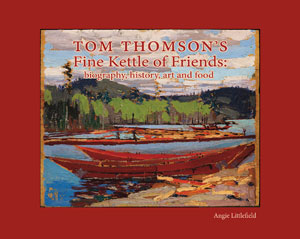![]()
Home | Angelika Hoerle | Tom Thomson | Angie's Projects | Norval Morrisseau | Art of Dissent | Walking with Oma | Books | Links
George Thomson Q&A | Margaret Thomson Tweedale Q&A | Tom Thomson Q&A | Imagining Tom in 1912 Toronto
Tom Thomson's Fine Kettle of Friends Advance Praise | Book Talks
![]()
REVIEWSOttawa Review of Books says"Tom Thomson's Fine Kettle of Friendsone of 10 outstanding summer books"
Ottawa Review of Books FACEBOOK | REVIEW Ottawa Review of Books says Tom Thomson's Fine Kettle of Friendsone of 10 outstanding summer booksTom Thomson’s Fine Kettle of Friends by Angie Littlefield | June 8, 2017 | Reviewed by Timothy Niedermann Canadians have a romantic image of the painter Tom Thomson as a solitary individual, paddling alone through the wilds of Ontario, vigorously sketching scenes from nature that he would convert into large oil canvasses at his Toronto studio—a man thoroughly, even exclusively, dedicated to his art, totally immersed in the creation of what have become iconic images of the Canadian landscape. And so much is true, except that he seldom travelled alone and he occupied himself with rather more than just sketching on those trips. He fished, hunted, picked berries and other wild edibles, had long conversations, and even longer silences in the deep summer nights. And one more thing, he was rather good at making doughnuts. Yes, doughnuts. While camping in the wilds of Algonquin Park, no less! And in social settings, he was also an avid dancer and versatile musician, hardly a wallflower. “What a delightful book! A great idea! Thank you for doing such excellent work.” Joan Murray, art historian and Tom Thomson scholar “I enjoyed the tasty outing with Thomson and Edgar Burke’s family on Fairy Lake including a too brief visit with an austere Winnifred Trainor.” Neil Lehto, author, Algonquin Elegy: Tom Thomson’s Last Spring. “It is appropriate that Littlefield devotes an entire chapter to Minnie, Tom’s favourite sister. No wonder that Tom, an adventurer himself, favoured this feisty girl who plundered her dowry to enrol in college, studying classics, language, music, art and more – and stuck to it for three years, eventually marrying (after some consideration) at age 32. The accounts of Tom and Minnie’s outings give a deep sense of their affection for each other, and their delight in the ‘delicious food’ served at Tom’s favourite McConkey’s on King Street.” Amanda Hale, author, In the Embrace of the Alligator, Sounding the Blood, My Sweet Curiosity and The Reddening Path. “I’m very impressed with the Archie Belaney chapter: a mix of document-based information with open speculation in a way that is quite compelling. Dennis Reid, author, A Concise History of Canadian Painting, editor, Tom Thomson. “What struck me was the amazing mobility of the Thomson family and their friends. They were peripheral, or central, to so many endeavours in our young country. Ms. Littlefield has shown us life in early Canada with a much richer palette than we might have imagined. Do join us for dinner!” Ruth Abernethy, sculptor and author of Life and Bronze. “Angie Littlefield has brought it all together: Tom Thomson, his history and his life; food and how it used to be and how it brought people together—and Canada with its history, everyday life and spelling. Finally, it’s not cutting out letters to save money by using American spelling. This book shows through people and food who we are, because of where we came from.” Rebecca Middleton, editorial researcher White Pine Pictures, including West Wind: The Vision of Tom Thomson. “I am very impressed with your latest Tom Thomson presentation and offer my humble comments on the outstanding research and writing. You have, again, advanced my writer’s inferiority complex. Your book is a real masterpiece with in-depth research and outstanding pictorial support!” Robert Lavack, Sweden/Canada, author of “Flying high with Morrisseau”, The Morrisseau Papers, Nun of That and “sometimes war chooses you”. “This lively book will give the reader a vivid sense of Tom Thomson as a personality beyond his art. Thomson’s friendships, in particular with the colourful J.W. Beatty, are wonderfully evoked.” Amy Furness, Rosamond Ivey Special Archivist & Head, Library & Archives, Art Gallery of Ontario. “What a wonderful book! It has been a real delight to read. Regardless of how familiar you might feel you are with Tom Thomson and his life, there is a freshness to how Angie Littlefield tells the story. Anyone interested in Thomson, early 19th century life or cooking will definitely enjoy this book.” Virginia Eichhorn, Director & Chief Curator, Tom Thomson Art Gallery. “This engagingly written book presents well researched narratives that enhance our understanding of Tom Thomson through facts and possibilities concerning his life. A good example is H.B. “Harry” Jackson accompanying Tom on his first visit to Algonquin in May 1912, a trip which was the initial spark in Thomson’s intense artistic love affair with the Park.” Ron Tozer, Algonquin Park Naturalist (retired) and author of Birds of Algonquin Park. Rocky Mountain Outlook:
Watch for Tom Thomson’s Fine Kettle of Friends
|
Angie Littlefield | 416.282.0646 | angie.littlefield@yahoo.ca

